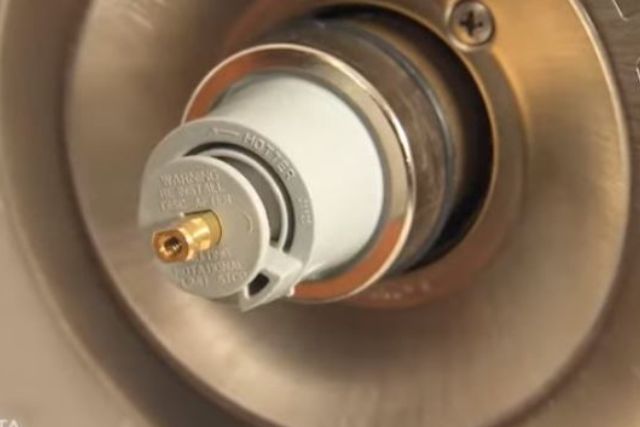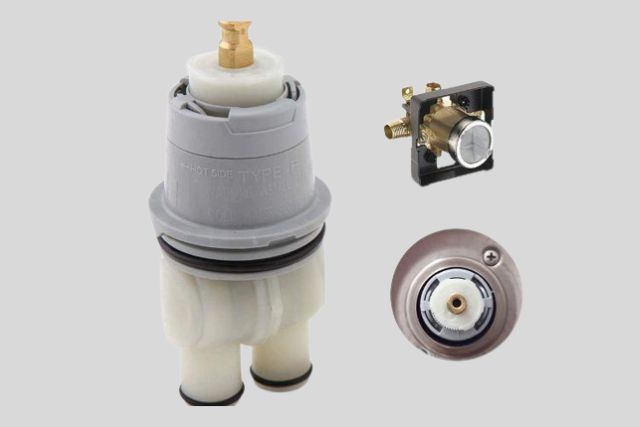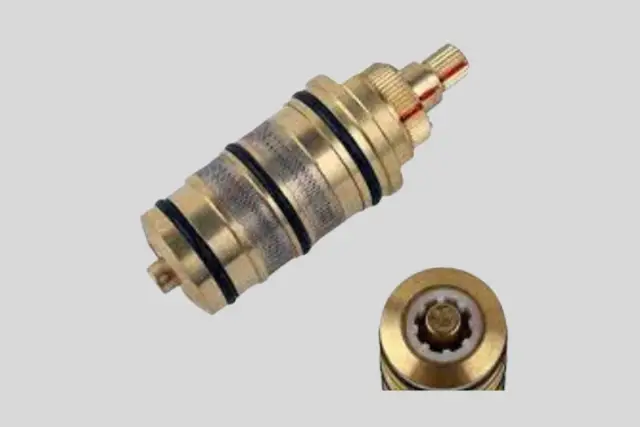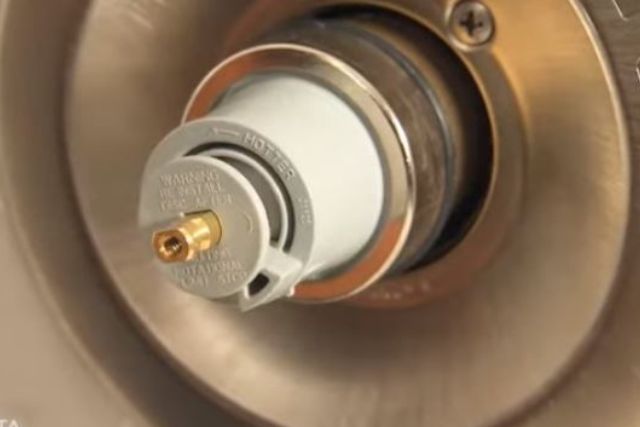Experiencing a sudden reduction in water pressure while in the shower can be quite frustrating. But trust me, you’re not alone here and it is a really common occurrence to the users. While there can be various reasons behind this issue, one frequently overlooked question is “Can a bad shower cartridge cause low water pressure?”
Yes, a malfunctioning cartridge can cause low water pressure in your shower. The issue is more likely related to the mineral build-up in the cartridge or internal damage to its components. However, you can easily resolve the issue by a thorough cleaning or you may need to replace the bad element at last.

Let’s dig deeper to learn details all about shower cartridge, how it affects your water flow, and the key solutions to restore the pressure.
Table of Contents
What Is A Shower Cartridge & What Does It Do?
The shower cartridge is an essential part of the shower valve that is specially designed to regulate the water flow to the entire shower system. Most shower cartridges also regulate and control the temperature of the water that comes out of the showerhead.

As with turning on the shower handle or lever, it starts controlling the water flow from the spout of the faucet and regulates water temperature from its holes.
In general, a standard shower cartridge typically has two main holes: one for hot water and one for cold water input. When you twist the hot water, the cartridge restricts the flow of cold water and opens the hot water holes.
Conversely, when you turn the handle counterclockwise, it restricts the hot water flow and allows more cold water in to have water at a lower temperature.
Lastly, when you flip the faucet handle, the cartridge releases water down the showerhead and shuts off the water supply completely.
What Are The Different Types Of Shower Cartridges?
There are different types of cartridges available for the shower system that come in different designs, features, and functions. The type of shower cartridge you have mainly depends on the shower valve or faucet system you have.
Here are the common types of shower cartridges you should know:
Single-Handle Cartridge: This type of cartridge is found in modern shower systems with single-handle faucets. Generally, it is designed to control both temperature and flow rate with a single lever.
Two-Handle Cartridge: Two-handle cartridges are used in double-handle faucets. Here, you will find two different controls for hot and cold water. By turning on each handle, it allows you to manually adjust the water temperature to your requirements.
Pressure-Balancing Cartridge: Pressure-balancing cartridges are specially designed to balance the water pressure between hot and cold water.

It also helps to prevent the chances of scalding in case the cold water pressure suddenly reduces. Commonly, you will find these cartridges in shower valves for residential bathrooms.
Thermostatic Cartridge: Thermostatic cartridges ensure a safe shower experience for the users by properly regulating the temperature of the water.

It features temperature dials that allow you to select the desired water temperature. When done, the cartridge automatically adjusts the flow of hot and cold water to achieve the set temperature.
What Causes A Shower Cartridge To Fail?
Several reasons may cause your shower cartridge to go bad. Hard water and mineral accumulation are the root of them. Besides, an imbalance of the water pressure between the cold pressure and the hot water or long wearing and tearing eventually causes the cartridges to fail.
1. Water Pressure Issues
In-balance water pressure between the cold and hot water is the common reason why your shower cartridge may fail when it shouldn’t. Basically, when there is a significant difference in the water pressure, it puts excessive pressure on this element, leading to leaks or wear and tear on the cartridge.
In worst cases, an imbalance in water pressure can affect the cartridge’s ability to mix hot and cold water accurately.
2. Lime-scale build-up
Hard water or mineral build-up is one of the most obvious reasons for the cartridge’s failure. It may be quite a common phenomenon to you if you are living in a hard water area. Naturally occurring minerals from the hard water accumulate in the internal components of the cartridge and create blockages.
This buildup restricts the flow of water through the cartridge and ultimately causes reduced water pressure. Scale deposits in the cartridge also make it challenging to regulate the water temperature correctly.
3. Incorrect Installation
If the cartridge isn’t installed correctly, it may cause several issues while in use. Like leaks, drips, or difficulty in controlling water temperature and flow. At times, improper installation can deteriorate the cartridge’s materials and cause it to fail
Can A Bad Shower Cartridge Cause Low Water Pressure In My Shower?
Yes, a bad shower cartridge can restrict the normal water flow and lead to low water pressure in your shower. This is generally related to strong lime-scale build-up in the cartridge or internal damaged component which restricts the flow of water through the cartridge.
A cartridge plays a crucial role in maintaining the water flow to your overall shower system. However, over time, shower cartridges can become clogged by dust and debris.
In worst cases, hard water minerals accumulate on the cartridge’s internal components, such as seals, gaskets, or flow passages. All that highly affects the function of the cartridge and causes various issues, including reduced flow rate.
How Does A Malfunctioning Shower Cartridge Affect Water Pressure?
There are several reasons that contribute to low water pressure while in your shower. Bad or malfunctioning shower cartridges are the leading one of them.
Here is how a defective cartridge affects in normal water flow rate from the main water supply line to your showerhead:
1. Worn Out Components:
Inside the cartridge, you will find several components and pathways that are designed to regulate the hot and cold water flow. But after long use or mishandling of the shower faucet, these components can easily wear out.
Especially, the O-rings and stems in the cartridge provide a watertight seal. When this component wears out it results in water leaking or bypassing the cartridge. This causes low water pressure to your showerhead.
2. Blockage In The Cartridge:
As mentioned above, shower cartridges tend to become clogged with mineral deposits, sediment, or debris from the water supply. This blockage restricts the water flow through the cartridge, leading to reduced water pressure at the showerhead.
3. Improper Installation:
If your valve cartridge isn’t installed correctly, it would be that the cartridge wasn’t installed correctly. The higher possibility is you have recently changed your shower system, but the plumber hasn’t set the cartridge as it should. This may be causing water leaks and difficulties in maintaining the water flow as recommended.
4. Damage Or Corrosion:
In general, the cartridges are made of metal components which are prone to corrode after long contact with water. A deteriorated or corroded cartridge will no longer be able to maintain adequate water pressure.
How To Troubleshoot A Bad Shower Cartridge?
If your shower cartridge isn’t functioning well, as mentioned above, several factors would be responsible here. You can fix this issue either by repair or you may need to replace the cartridge as a whole.
For instance, here we have a few troubleshooting tips for you to deal with a malfunctioning shower cartridge:
Phase 1: Clean Your Shower Cartridge
As for the first step, you need to inspect your cartridge for blockage. It is possibly clogged with dust and debris, leading to this issue. If so, you can easily resolve the issue by a thorough cleaning.
But here it is worth mentioning that the cleaning procedures will depend on the manufacturers or better knowing you can read your shower manual to clean the cartridge thoroughly.
Here we will guide you through the step-by-step instructions below to clean the cartridge of your shower system:
Step #1: First up, take a drop cloth, and cover the shower drain to prevent any pieces from falling down the drain.
Step #2: Turn off the water supply to your shower. Once the water is off, remove the diverter button. If you don’t have a diverter button, then simply skip this step.
Step #3: Once the diverter is out of the way, your next step is to remove the trim.
Generally, it will be attached either by a few screws or a plug button. Using a Philips screwdriver, remove the screws or plug button on the valve stem and remove the handle and then cover the plate.
Step #4: When done, you can easily get access to the valve assembly. Take an open-end adjustable wrench and carefully loosen the nut holding the shower cartridge in place.
Step #5: Pull the shower cartridge straight out of the valve and then start cleaning. For instance, you may need a cartridge puller if you find the cartridge is stuck.
How To Clean a Clogged Cartridge?
Step #6: Take a soft-bristled brush, including a toothbrush, and scrub the cartridge to remove all the impurities. You can use a couple of drops of washing-up liquid for better cleaning.
When done, rinse it with clean water.
Step #7: In case, the cartridge is clogged by hard water mineral buildup, soak the element in a mixture of a vinegar solution, and leave it for a couple of hours.
This will help to dissolve the mineral buildup. Then use a toothbrush and rub the cartridge gently. Finally, rinse the cartridge thoroughly with clean water to remove any vinegar or debris.
Phase 2: Check For Leaks
After cleaning the cartridge, it’s time to visually inspect the element for any leak or damage. These leaks may be occurring from the cartridge itself or from the damaged O-rings and gaskets surrounding it.
For instance, replacing the damaged part will be enough to resolve the issue. This will be applicable if you find the cartridge in working condition.
Here’s all about how you will replace the defective cartridge O-rings:
- Locate the O-rings on the valve body. Use a sharp utility knife and Cut off the worn O-rings from the assembly.
- Take the new O-rings and rub a thin layer of plumber’s grease or silicone-based lubricant on the replacements. Before installing it to your shower cartridge, make sure they are the correct size and type for your specific cartridge
- Now slide them along the cartridge body and position them in the same locations as the old ones. Make sure they are seated properly.
- When done, reinsert the cartridge into the valve body, ensuring it’s properly aligned and seated in place.
- Reassemble the shower handle and turn on the water supply. Now check if there is adequate water pressure from your showerhead.
If replacing the O-rings doesn’t resolve the issue, you may also need to replace the surrounding gaskets. To do so:
- Take a screwdriver and disassemble the screw, holding the gaskets in place.
- Then carefully pull out the old gaskets and replace them with the new ones.
- Turn on the water supply and check for leaks. If all is okay, reassemble the shower parts.
Phase 3: Replace The Bad Cartridge
If cleaning and replacing the O-rings fails to resolve the issue, be sure your cartridge is longer for use now. The best possibility is it entirely deteriorates and you need to replace it with new ones.
As long as you have the correct cartridge replacement part in your hand, you can replace it yourself. With the old cartridge out, make sure the shower valve assembly is in good condition. If needed, use a soft cloth or a brush to clean the valve body as well.
Now prepare to install the new cartridge. For instance,
- Insert the new cartridge into the faucet body. Ensure it is properly aligned and seated in place.
- Now slide in the retaining clip and secure it with a wrench. Be careful not to overtighten the clip as it may damage the cartridge or valve.
- After installing the new cartridge, reattach the shower handle and turn on the water supply. Hope your low shower water pressure is resolved now.
How Much Does It Cost To Replace A Shower Cartridge?
On average, you will expect to pay between $100 and $400 to replace a shower cartridge. But here various factors will impact the replacement cost. That includes the type of cartridge you are installing, the cost of labor, the brand and model of your shower fixture, and your location.
Here’s a short break down on the shower cartridge replacement cost:
Labor Cost: The plumber’s cost will depend on their rates per hour, In general, it will be in between $45 to $200 per hour and cartridge replacements can take two to three hours on average to complete.
The Cost Of The Cartridge: The cost of the replacement shower cartridge can range from $15 and $85, depending on the brand, quality, and type of cartridge. For example, Brass and ceramic cartridges cost more but they tend to last longer than the plastic ones.
Additional Cost: You may need some additional materials like a plumber’s grease, screwdrivers, pliers, an adjustable wrench, or a cartridge puller that costs extra.
DIY VS Hiring A Pro: Cost To Replace A Shower Cartridge
In general, professional plumbers charge around $45 to $200 per hour. That means, if you hire a professional plumber to replace the shower cartridge, then you can expect to pay anywhere from $90 to $400, including the materials. Conversely, DIY shower cartridge replacement costs between $50 and $120. This is the estimated price range including the replacement cartridge and other needed tools or materials.
Why Is There Low Water Pressure After Replacing Cartridge?
Well! You have replaced your old shower cartridge to resolve the low shower pressure issue suspecting this element is defective at all. But the frustrating twist may start here if still there is less or low water pressure after replacing the cartridge.
Let’s see which things are reducing the water pressure even after you have installed a brand-new cartridge in your shower system:
1. Partially Closed Water Supply Valve
After replacing the old cartridge, you might forget to open the line valve fully. If that is so, you will get less pressure from the shower. Just head to the main supply line and open it completely to increase the water flow.
2. Handle Not Adjusted
If the shower handle or knob is not aligned correctly, the pressure regulation won’t happen at all. Even after they are all okay with the charge. Inspect the handle for any loose parts and secure it back to the right place.
3. Clogged Shower Head
If the shower head is clogged up by dust and debris, it is obvious you will get adequate water flow from it. It is worth it to inspect the shower head aerator and clean it thoroughly if required.
4. Improper Installation Or Using Incompatible Cartridge
Last but not least, the best chance is the cartridge is not installed properly. Either the valve body doesn’t go inside or the O-ring is not set properly.
In this instance, you will need to disassemble the cartridge again and verify whether it is installed as per manufacturer instructions. Also, make sure you are using a compatible model; as a replacement.
Essential Maintenance Tips To Prevent Shower Cartridge Issues?
A malfunctioning shower cartridge leads to several issues like dripping or running water, reversed hot and cold water, water not getting hot enough, and so on. But you can easily prevent these issues by properly maintaining your shower cartridge.
For instance, here we have some pro tips that will help you keep your shower cartridge in tip-top condition:
Tip 1: Keep your shower head clean to prevent dust and sediment build-up in the shower valve inside. You may need to clean the elements more frequently if you are living in a hard water area.
Tip 2: As a prevention tip, you can install a water softener for your home if you have hard water with a high mineral content. This will help to prevent mineral buildup and scale in the shower head and fixture.
Tip 3: Besides cleaning, inspect your shower cartridge to check for leaks and other damages to its components. Especially the O-rings that tend to wear out by frequent use. For instance, consider replacing the O-rings before it causes another severe plumbing issue.
Tip 4: Periodically, verify the tightness of the retaining nut to ensure that your shower cartridge is secured enough.
Tip 5: Regularly test your shower for consistent water pressure and temperature. If you notice any malfunction, follow the manufacturer’s guidelines and recommendations to resolve the issue. In case it is beyond repair for you, consider contacting a professional plumber for further inspection.
Other Major Reasons For Low Water Pressure In Shower?
Besides the bad cartridge, several factors can contribute to low water pressure in your shower. Have a short glimpse at the quick table below, highlighting all the reasons for this issue with their recommended fixes:
| Probable Reasons | Recommended Fix |
| Clogged Shower Head | Disassemble the showerhead parts and clean them with the appropriate cleaning solutions. |
| Worn-out mixing valve | Replace the bad mixing valve |
| Malfunctioning pressure balancing valve | Adjust the valve and if required, replace it. |
| Faulty water pressure regulator | Verify the pressure regulator is set within the recommended water pressure range (usually 46-60 psi). If needed, replace the bad one. |
| Corroded or leaking pipe | Inspect the plumbing pipes for mineral build up or leaks. You will need to replace the deteriorated pipes. |
| Water heater issues | Check for sediment buildup in your water heater as it also leads to low water pressure. If required, flush your water heater unit. |
FAQs:
How long does a shower cartridge last?
The lifespan of a shower cartridge will depend on different brands, the material quality, and how well you are maintaining it. In general, the cartridge should last 5 to 10 years. Some expensive models like Moen, Delta, or Kohler will last up to 30 years.
When should I replace my shower cartridge?
Here are a few alarming signs telling you that your existing shower cartridge needs an urgent replacement:
1. Dripping or running water
2. Hot and cold water reversed
3. No hot water or water isn’t getting hot enough
4. Difficulties in turning the shower handle or getting stuck at all
How often should I change the shower cartridge?
The manufacturers recommend changing your shower cartridge at least every 12 months. It will help to retain your shower water pressure as it should and you will enjoy a consistent temperature during your shower.
Can I replace a shower cartridge myself?
Yes, it is quite possible to replace a shower cartridge yourself as long as you have compatible cartridge replacement parts. Manage the right tools, follow the instructions in our guide, and replace your shower cartridge effectively.
Can a bad shower cartridge lead to other plumbing issues in my home?
Yes, definitely, a bad shower cartridge can cause several more plumbing issues in your house. If the bad cartridge is left unaddressed, it can cause water hammers, water wastage, mold, and mildew growth behind the wall or wear and tear on other parts of the shower fixture
In Closing
We know how much it is frustrating when you are enjoying your shower and notice a sudden reduction in the water pressure. As with other factors, you may have a question “Can a bad shower cartridge cause low water pressure.” The short and quick answer is “Yes”.
Even a malfunctioning shower cartridge can be a leading culprit behind low water pressure in your shower. As an essential part of the shower valve, it regulates the water flow and temperature of the shower system.
However, due to the minerals build up or wear and tear in the internal components, it is obvious the efficiency of the cartridge will reduce, resulting in reduced water pressure.
But with the proper maintenance and regular cleaning of the shower valve, you can easily prevent this issue as well as many more potential plumbing problems and water wastage.


About Atikul
Atikul Islam shares his expertise with various tips & tricks to fix the problems with home appliances related to toilet, kitchen, bathroom, heating, & cooling systems. Read to know more about Atikul Islam.